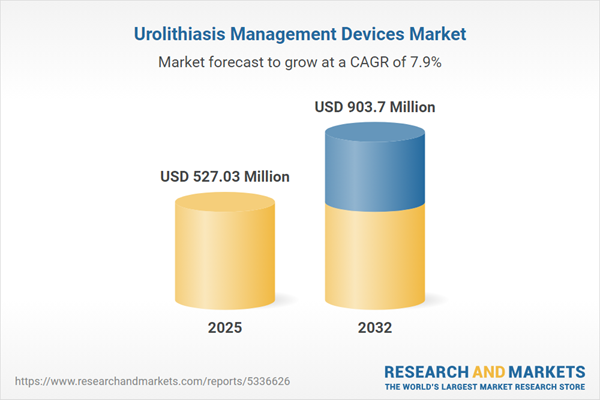Speak directly to the analyst to clarify any post sales queries you may have.
The Urolithiasis Management Devices Market is evolving rapidly, driven by ongoing advancements in minimally invasive technologies, growing procedural demand, and changing regulatory dynamics. As senior decision-makers seek actionable strategies for growth and risk mitigation, this report provides a holistic view tailored to the unique challenges and opportunities of the urolithiasis device landscape.
Market Snapshot: Urolithiasis Management Devices Market Insights
The Urolithiasis Management Devices Market grew from USD 490.76 million in 2024 to USD 527.03 million in 2025, with a projected CAGR of 7.93% and expectations to reach USD 903.70 million by 2032.
This strong growth reflects increasing prevalence of urinary stone disease, a rising preference for device-based interventions, and the adoption of advanced treatment modalities across global healthcare systems. Senior leaders can leverage this momentum to inform product development and market entry strategies.Scope & Segmentation
- Device Types: Guidewires, Lithotripters, Stents, Ureteroscopes
- Treatment Types: Extracorporeal Shock Wave Lithotripsy, Intracorporeal Lithotripsy, Percutaneous Nephrolithotomy
- Device Materials: Metal-Based Devices, Polymer-Based Devices
- Applications: Bladder Stones, Kidney Stones, Ureteral Stones
- End Users: Ambulatory Surgical Centers, Hospitals, Specialty Clinics
- Regions Covered: Americas (United States, Canada, Mexico, Brazil, Argentina, Chile, Colombia, Peru) Europe, Middle East & Africa (United Kingdom, Germany, France, Russia, Italy, Spain, Netherlands, Sweden, Poland, Switzerland, United Arab Emirates, Saudi Arabia, Qatar, Turkey, Israel, South Africa, Nigeria, Egypt, Kenya) Asia-Pacific (China, India, Japan, Australia, South Korea, Indonesia, Thailand, Malaysia, Singapore, Taiwan)
- Key Companies: Advanced MedTech Holdings, AKSM Ltd., Avvio Medical, Becton Dickinson and Company, Boston Scientific Corporation, Calyxo Inc., Coloplast A/S, Cook Group, DirexGroup, Dornier MedTech, Dyne Medical Group, EMS Electro Medical Systems SA, EDAP TMS SA, Elmed Lithotripsy Systems, EndoTheia Inc., Karl Storz, Nissha Medical Technologies, Olympus Corporation, Quanta System S.p.A., Richard Wolf GmbH, Siemens Healthineers, SonoMotion, Teleflex Incorporated
Key Takeaways for Senior Market Leaders
- Device innovation is reshaping treatment paradigms, with minimally invasive, endoscopic, and laser-based systems delivering improved precision and patient comfort.
- Next-generation guidewires and biocompatible stents improve procedural workflow, postoperative outcomes, and drive differentiation in competitive tenders.
- Regional dynamics matter; strong adoption and reimbursement in the United States and Western Europe contrast with emerging infrastructure in Asia-Pacific and the Middle East.
- Collaborative partnerships between device manufacturers, academic institutions, and healthcare providers support cross-disciplinary innovation and accelerate market entry.
- User-centric design and workflow integration are increasingly prioritized, influencing buyer preferences at both the clinical and administrative levels.
- Value-based procurement and real-world clinical evidence play a growing role in shaping device selection and reimbursement pathways.
Tariff Impact and Supply Chain Challenges
Recent U.S. tariff measures on imported medical devices have increased procurement costs for essential components, such as polymers and specialized electronics. Manufacturers now face elevated expenses, extended lead times, and the need for greater inventory buffers. Supply chain resilience is addressed by nearshoring production, diversifying supplier networks, and negotiating preferential agreements to minimize disruptions and ensure competitive device availability to healthcare providers globally.
Methodology & Data Sources
This report integrates rigorous secondary research from peer-reviewed journals, clinical trial registries, regulatory databases, and policy documents. Primary interviews with urologists, procurement managers, and device engineers provide market granularity and real-world perspectives. Data validation includes cross-referencing multiple sources, with a multidisciplinary team ensuring analytical accuracy and consistency.
Why This Report Matters
- Enables senior leaders to benchmark product portfolios, anticipate regulatory shifts, and assess the commercial impact of new technologies in urolithiasis management.
- Supports informed investment and procurement choices by analyzing evolving reimbursement models and global supply chain considerations.
- Delivers actionable insights into regional market dynamics and competitive strategies for targeted business growth.
Conclusion
As the urolithiasis management device market advances, stakeholders who align innovation with operational resilience and regulatory awareness will secure stronger positioning. This report provides the foundation for strategic planning and future-proof decision-making in a changing healthcare landscape.
Additional Product Information:
- Purchase of this report includes 1 year online access with quarterly updates.
- This report can be updated on request. Please contact our Customer Experience team using the Ask a Question widget on our website.
Table of Contents
3. Executive Summary
4. Market Overview
7. Cumulative Impact of Artificial Intelligence 2025
Companies Mentioned
The companies profiled in this Urolithiasis Management Devices market report include:- Advanced MedTech Holdings
- AKSM, Ltd.
- Avvio Medical, Inc.
- Becton, Dickinson and Company
- Boston Scientific Corporation
- Calyxo Inc.
- Coloplast A/S
- Cook Group Incorporated
- DirexGroup
- Dornier MedTech GmbH
- Dyne Medical Group Inc.
- E.M.S. Electro Medical Systems S.A.
- EDAP TMS SA
- Elmed Lithotripsy Systems
- EndoTheia, Inc.
- Karl Storz GmbH & Co. KG
- Nissha Medical Technologies
- Olympus Corporation
- Quanta System S.p.A.
- Richard Wolf GmbH
- Siemens Healthineers
- SonoMotion
- Teleflex Incorporated
Table Information
| Report Attribute | Details |
|---|---|
| No. of Pages | 198 |
| Published | November 2025 |
| Forecast Period | 2025 - 2032 |
| Estimated Market Value ( USD | $ 527.03 Million |
| Forecasted Market Value ( USD | $ 903.7 Million |
| Compound Annual Growth Rate | 7.9% |
| Regions Covered | Global |
| No. of Companies Mentioned | 24 |









